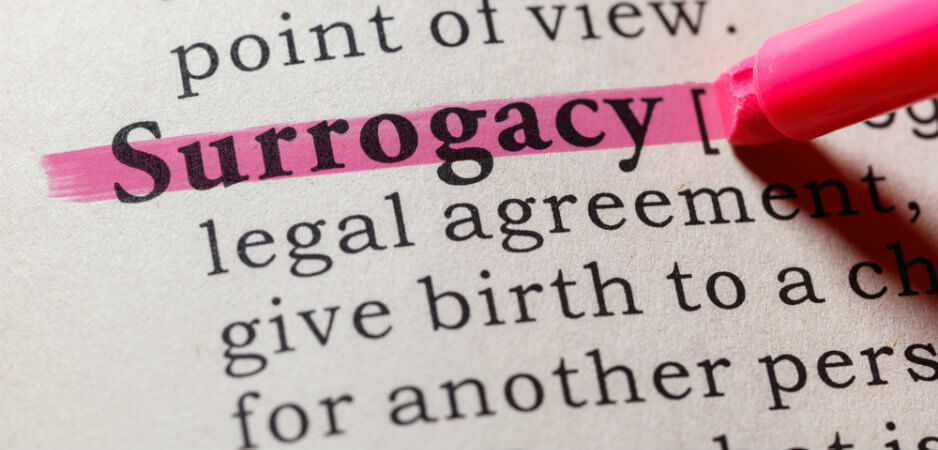The main conceptual problem in surrogacy — the production and sale of a child — reduces both women and children to commodities in commerce: things.
Many articles and books can be found describing the horrors of surrogacy. Exploitation is common, with abuse and slave-like conditions for women. Often, several eggs are implanted to ensure that one of them will produce; but if that results in multiple embryos, the birth mother may be forced to have an abortion for fetal reduction. At a later stage in the pregnancy, genetic tests are often done, and if it is found that one or more of the eggs is damaged, an abortion will be required even if over the objection of the birth mother.
Likewise, caesareans are often required. The baby born though a caesarean does not have a temporary misshapen head or wrinkled look, but it also does not have the immunities and health benefits passed on by the mother during a vaginal birth. A caesarean then may prohibit the birth mother from having her own vaginal birth. That is just one of many medical harms to the birth mother that are not considered.
Abandonment and abuse of children is common if the intending parents divorce, change their mind or decide they wanted a different child than the one they got. The abandonment of a twin boy with Down’s Syndrome by an Australian couple resulted in Thailand banning surrogacy. Some intended parents have been found to deliberately obtain a child to abuse.
Trafficking and sale of women and children from “baby farms” has occurred in Cambodia and in other places. Illicit adoptions occur when the child has been kidnapped but pawned off as a surrogate. There are multiple violations of medical confidentiality and ethics, health issues for both mother and child, not to speak of the immediate and future psychological impact on the mother, her family and the child. Both the desire to keep or refusal to take (much more common) the child often cause family disruption, and statelessness and nationality issues for the children — and the list goes on.
Most countries have chosen to prohibit surrogacy because of the inherent problems both in concept and operation. Only four countries allow it (Russia, Ukraine, Georgia, Israel) and in three others some of their states allow it (Mexico, US, Canada). Muslim, Catholic and social democratic countries all prohibit the practice, though for very different reasons. Because of abuses of local women, Nepal and India have recently banned commercial surrogacy.
A Language Problem
Language is one problem. According to the Webster’s New Collegiate Dictionary, surrogate means “to choose in place of another, substitute, to put in the place of another, to appoint as successor, deputy, or substitute for oneself.” Under any of these definitions, the surrogate mother is the female intended parent, not the woman who is actually giving birth. For millennia, the mother was the woman giving birth. The substitute is another female who then does the job of mothering. So the intending parent female is the surrogate mother, not the birth mother. Yet in every contract, research article, news story and law, the woman giving birth is referred to as the surrogate.
The birth mother is not in the place of another; she is the mother. That was the law in every country in the world until now. We always knew who the mother was — she was the one who gave birth. That is the first definition of a mother. We weren’t so sure about the father, which is why women’s freedoms have been curtailed so men could be assured of their lineage. Now, with DNA, we can be scientifically certain of the father. So the first “success” of the surrogacy movement was to change the definition of the mother and remove the woman who gave birth from the frame. By applying the word “surrogate” to the wrong person, it depresses the position of the birth mother but does not elevate the position of the other woman. Instead, the position of the sperm donor, or the father, is elevated as the only person with rights.
More accurately, we should call the birth mother a handmaid, from Margaret Atwood’s 1986 book, The Handmaid’s Tale, now a popular TV show. Like the handmaid, the birth mother is impregnated by a stranger; her body is closely controlled regarding what she can eat, exercise, see, listen to and do so as to deliver a healthy specimen. When born, the child is taken from her and given to another woman.
The second language problem concerns the donor. A donor is “one who gives, donates, or presents.” Donate means to “make a gift.” Most donors except the intended parents are not “giving” eggs or sperm. They are being paid. The sperm or eggs of a Caucasian model, a world-class athlete or an intellectual genius sell for far more than the average Joe. That makes the donor a seller. But since biological material can’t be sold in most countries, specifically in the 29 states that have ratified the Vienna Convention, a legal fiction has been created to pretend it’s a donation. The second definition of donor had to be created to read “one used as a source of biological material,” to evade the law.
Another legal fiction is the payment of money to the birth mother for “expenses” in a so-called altruistic surrogacy. Everyone knows it’s not for expenses, but for the delivery of a child to another person. If she doesn’t produce a child, or if the child dies, she doesn’t get the money. Surrogacy is about money from start to finish. In the US the intending parents pay approximately $150,000, divided between the birth mother ($20,000-$30,000), the egg donor ($5,000-$10,000), the doctor ($30,000), the lawyer ($10,000), the agency ($20,000), which still leaves $50,000 unaccounted for. However the cost can be cut in half in other countries such as Mexico, India and Thailand. (It is estimated that in India alone the annual income from surrogacy was worth anywhere between $50 million and $2.3 billion.)
Intermediaries exploit the misguided desires of the intending parents and the often-desperate economic need of the birth mother to pocket the difference. This structure makes a mockery of consent, medical ethics and the rule of law.
Conceptual Problems
It is a universal norm that no one should be exploited, and that everyone should give informed consent to all medical procedures. But how one defines and operationalizes informed consent and prevents exploitation and abuse is not so simple. As always, the devil is in the details. In some states, particularly in the US, a contract is given great weight. Contract law is a woefully inadequate way to deal with such weighty issues that implicate human rights and international conventions on children’s rights, women’s rights, trafficking, slavery and racism.
One conceptual problem is the belief that a woman who cannot have a child is a failure, and the corresponding myth that a man who can’t father a child is emasculated and less a man. That reduces both women and men to their mechanized body parts divorced from human dignity. While certainly many people want to have children, and in at least three countries (US, India and Ireland) there is a right to procreate, there is no right to a child anywhere in the world. No one can guarantee that your attempts at procreation will be successful, or that the child produced will be to your liking.
The main conceptual problem in surrogacy — the production and sale of a child — reduces both women and children to commodities in commerce: things. This is a violation of every human rights concept and convention one can name. The process of pregnancy and birth becomes a mechanistic procedure in which the woman is just a machine. The mother is framed and often referred to as a womb, an oven, a breeder, a producer, a carrier — not a human with inherent rights. The child has become a product, a commodity. These concepts are completely antithetical to the overarching international human rights principle that every person is owed human dignity by dint of birth. Reducing women and children to machines and products violates their inherent dignity and worth.
Erasing the Mother
Once the birth mother was removed from the frame both by misapplication of language, labeling and contractual clauses, the next step was to elevate the sperm. Previously, the birth mother was always the mother with the father determined by operation of law (the spouse of the mother), or he consented. Absent that, his parentage had to be proven by DNA. So absent surrogacy, the mother is determined by birth, the father by DNA.
But with surrogacy, that changes. The mother is no longer determined by birth. In most countries, she’s the legal mother because she gave birth to the child. But in the contract, she signs away her legal rights. The female of the “intending parents” may or may not be the egg donor and so may or may not have any genetic link with the child. But it doesn’t matter either way: She is not the mother under law even if she was the egg donor. So the child is legally motherless at birth.
We shared an article this morning about how “the U.S. fertility industry remains largely unregulated and routinely offers services outlawed elsewhere.” If you’re curious about what’s allowed where, here’s our state-by-state summary of U.S. surrogacy laws. https://t.co/81ceoXmGzp pic.twitter.com/m8yGUx5P5H
— CBC Network (@CBCnetwork) January 2, 2019
However, if the male in the intending parents is the sperm donor, he is the father. So the egg donor, a female who has a genetic link with the child, is not the mother. The birth mother who actually nourished with her body and gave birth to the child is not the mother. But the male who donated sperm — and then had nothing more to do with the entire process — is the father. His sperm counts more than the egg of one female or nine months of pregnancy and the act of giving birth by another.
It is obvious that women and men are treated differently in that his genetic material makes him the father, but her genetic material does not make her the mother. Women and men are also treated differently because the woman who actually carried the child and gave birth has fewer rights than the male who only donated sperm. If there is a genetic link, sperm rules. If there is no genetic link, sperm still rules, especially in the US, where the contract has been held to override the rights of the birth mother.
Israel requires a genetic link, and if the intended parents are a couple, the sperm used must be that of the intended father. If the intended parent is a single female, her egg must be the donor egg so in either case there is a genetic link to an Israeli citizen. But a married woman could not use her egg with donor sperm and qualify as an intending parent even if she was an Israeli citizen. Therefore, women are treated differently and as less important than men. While the genetic father has rights, the genetic mother has none. Both the birth mother and the genetic mother are erased.
Those opposed to surrogacy analogize it to trafficking and sale of children, both of which are violations of international law and human rights. Others argue that it is a runaway train too late to stop. That is clearly not true. Only seven countries allow it — that’s hardly a runaway train. Slavery was universal across the globe for 400 years. It created enormous profit for traffickers, slave owners and the economy. But in 1926, the world ratified a Slavery Convention and updated it in 1956. Let us not take 400 years to fix this wrong but learn from our earlier mistakes.
Modern-Day Slavery
Slavery still occurs, some cry. Yes, and so does murder, though it too is outlawed the world over. But that doesn’t mean our response should be to accept it because it’s widespread. Instead we need to take action to prevent the exploitation and protect the victims. We will need conventions on what to do with the stateless children or those abandoned by intended parents who rejected their purchase. We will need laws to prevent and punish those who continue to traffic and sell women and children in the baby trade. None of that prevents us from adopting a convention to eliminate surrogacy itself as the underlying violation.
Some agency feminists argue that we should have no such convention because women have the agency to choose whatever they want to do with their bodies to make the best decisions they can in the difficult situations they may be in. Decisions cannot be defined as involving agency if they are driven by coercion, violence or extreme poverty. Even though some women will claim they are happy to carry one, two or even three babies for someone else, that does not negate the argument.
Many slaves made the best of slavery too. Some even opposed abolition. Some earned enough money to buy themselves and their families out of slavery — a thought abhorrent today. Making do with what you have has always been a survival technique. It does not mean that the condition is acceptable because people find a way to survive. Human rights are not just about survival — it’s about human dignity and respect. We have a duty to speak out and say these conditions are not acceptable.
No one is blaming the woman for her decisions, nor for the difficult situation she may be in. We know that racism, sexism and colonialism drive this practice. The facilitators are the real money-makers no different from traffickers. The intended parents often let their desperation outrun their humanity The international human rights community needs to say no to the violation of human rights that surrogacy entails both in concept and in operation.
For 5,000 years, patriarchy has lorded over women primarily by violence and control of their sexuality. But patriarchy could not avoid one thing — it was women who gave birth. Women could do something — without which there would be no life — that men could not. With surrogacy, patriarchy has eliminated women from the picture. The birth mother has been made just a mechanistic part while the important aspect of the birth process becomes the sperm. The attempt to control every aspect of women’s lives is not new. Surrogacy is just another iteration. We must recognize it for what it is and fight to eradicate it.
The views expressed in this article are the author’s own and do not necessarily reflect Fair Observer’s editorial policy.
Support Fair Observer
We rely on your support for our independence, diversity and quality.
For more than 10 years, Fair Observer has been free, fair and independent. No billionaire owns us, no advertisers control us. We are a reader-supported nonprofit. Unlike many other publications, we keep our content free for readers regardless of where they live or whether they can afford to pay. We have no paywalls and no ads.
In the post-truth era of fake news, echo chambers and filter bubbles, we publish a plurality of perspectives from around the world. Anyone can publish with us, but everyone goes through a rigorous editorial process. So, you get fact-checked, well-reasoned content instead of noise.
We publish 2,500+ voices from 90+ countries. We also conduct education and training programs
on subjects ranging from digital media and journalism to writing and critical thinking. This
doesn’t come cheap. Servers, editors, trainers and web developers cost
money.
Please consider supporting us on a regular basis as a recurring donor or a
sustaining member.
Will you support FO’s journalism?
We rely on your support for our independence, diversity and quality.







